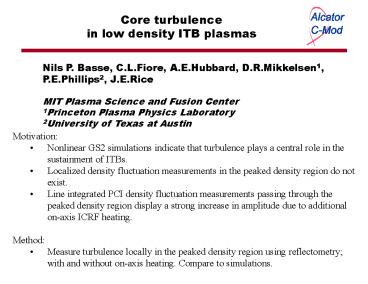Core turbulence - PowerPoint PPT Presentation
Title:
Core turbulence
Description:
Core turbulence in low density ITB plasmas Nils P. Basse, C.L.Fiore, A.E.Hubbard, D.R.Mikkelsen1, P.E.Phillips2, J.E.Rice MIT Plasma Science and Fusion Center – PowerPoint PPT presentation
Number of Views:45
Avg rating:3.0/5.0
Title: Core turbulence
1
Core turbulence in low density ITB plasmas
Nils P. Basse, C.L.Fiore, A.E.Hubbard,
D.R.Mikkelsen1, P.E.Phillips2, J.E.Rice MIT
Plasma Science and Fusion Center 1Princeton
Plasma Physics Laboratory 2University of Texas at
Austin
- Motivation
- Nonlinear GS2 simulations indicate that
turbulence plays a central role in the
sustainment of ITBs. - Localized density fluctuation measurements in the
peaked density region do not exist. - Line integrated PCI density fluctuation
measurements passing through the peaked density
region display a strong increase in amplitude due
to additional on-axis ICRF heating. - Method
- Measure turbulence locally in the peaked density
region using reflectometry with and without
on-axis heating. Compare to simulations.
2
Core turbulence in low density ITB plasmas
As target plasmas we will use low density, low
current EDA H-modes developed by Amanda Hubbard
in May 2003 (e.g. 600 kA shot 1030530020). Power
deposition will be changed from on- to off-axis
to enable ITB formation.
88 GHz reflectometry spectrogram showing two low
density EDA H-modes.
Thomson density profiles in L-mode (black) and
low density EDA H-mode (red).
3
Core turbulence in low density ITB plasmas
Once a suitable target plasma has been made, we
would scan the density so the reflectometer
channels reflect off different parts of the
ITB. Scans of on-axis heating power would
follow. From PCI measurements we know there is a
significant increase of non-localized turbulence
in response to on-axis heating.































